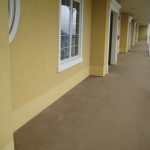While there is no one “most” important component of any given building envelope system, flashings are certainly critical parts. Whether it be roofing (flat or sloped), exterior cladding (brick, siding, EIFS, etc.) or windows and doors, flashings play a key role in the success of these systems.
 Flashings can consist of metal, sheet materials, or even liquid-applied membranes and are typically located at key areas (window/door perimeters, wall transitions, penetrations through roofs or walls, etc.) that would otherwise be prone to leakage. Their primary functions are to keep water away from vulnerable components and/or redirect it away from interior spaces.
Flashings can consist of metal, sheet materials, or even liquid-applied membranes and are typically located at key areas (window/door perimeters, wall transitions, penetrations through roofs or walls, etc.) that would otherwise be prone to leakage. Their primary functions are to keep water away from vulnerable components and/or redirect it away from interior spaces.
The cost of installing proper flashings is a relatively low percentage of an overall system. On the other hand, the effects and costs associated with missing or improper flashings can be extreme.
We regularly encounter the consequences when flashings are not included or are improperly installed. In addition to obvious problems (interior water penetration) rot or corrosion of framing and other concealed building elements can develop and progress unnoticed. Such  damage can be extensive and even disturbing.
damage can be extensive and even disturbing.
The accompanying photographs show what can happen when an EIFS assembly lacks flashings to collect and divert water away from internal elements. Repeated and prolonged wetting of the underlying wood components produced the severe damage you see and it went undetected until we opened the system up for inspection.

 anting trees around your property and near your buildings, think in the long term. That small tree will eventually become big, maybe even really big. We get calls related to foundation problems and wall cracks caused by the roots of big trees which were placed too close to the building many years before. Tree roots can exert excessive pressure on the building foundation and walls and lead to structural damage, foundation movement, and water infiltration. Unfortunately, to prevent additional damage to the building the big beautiful tree that has been around for so long typically has to be removed.
anting trees around your property and near your buildings, think in the long term. That small tree will eventually become big, maybe even really big. We get calls related to foundation problems and wall cracks caused by the roots of big trees which were placed too close to the building many years before. Tree roots can exert excessive pressure on the building foundation and walls and lead to structural damage, foundation movement, and water infiltration. Unfortunately, to prevent additional damage to the building the big beautiful tree that has been around for so long typically has to be removed.












